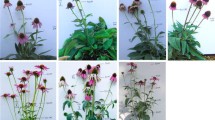Summary
The morphological and physiological evaluation of single ascorspore lines (F1) obtained from 4 production strains of Claviceps purpurea and the subsequent production and evaluation of an F2 from two of these strains has shown:
-
1.
The breeding system responsible for the sexual cycle of C. purpurea is characterized by monoecism and self-compatibility.
-
2.
Heterokaryosis is neither required for the completion of the life cycle nor for alkaloid synthesis.
-
3.
The huge variability in both mycelial morphology and alkaloid spectra makes it evident that all production strains are highly heterogeneous.
-
4.
A correlation between morphology and an alkaloid pattern was not found.
-
5.
Alkaloid production is, however, correlated with distinct genotypes.
-
6.
In some cases an increase in the total alkaloid content and in the formation of specific alkaloids was also found, showing that the genetic control of these metabolites may be accessible.
Taken together these results open up the way to concerted breeding with Claviceps purpurea with the object of improving alkaloid production.
Similar content being viewed by others
Literature
Amici, A.M.; Scotti, T.; Spalla, C.; Tognoli, L.: Heterokaryosis and alkaloid production in Claviceps purpurea. Appl. Microbiol. 15, 611–615 (1967)
Bekesy, N.: Über die vegetative und generative Übertragung von Mutterkorneigenschaften. Z. Pflanzenzüchtung 35, 461–496 (1956)
Bekesy, N.: The inheritance of the alkaloid content of ergot in parasitic and saprophytic cultures. In: Genetics of Industrial Microorganisms. (Eds. Vanek, Z., Hostalek Z., Cudlin, J.) 375–392. Academia Prague 1973
Corbett, K.; Dickerson, A.G.; Mantle, P.G.: Metabolism of the germinating sclerotium of Claviceps purpurea. J. gen. Microbiol. 90, 55–68 (1975)
Esser, K.: Kryptogamen. Berlin-Heidelberg-New York: Springer 1976
Esser, K.: Concerted breeding in fungi and its biotechnological application. Endeavour New Series 1, 143–148 (1977)
Esser, K.; Tudzynski, P.: Genetic control and expression of senescence in Podospora anserina. In: Viruses and Plasmids in Fungi. (Ed. Lemke, P.) New York: M. Dekker (in press)
Mantle, P.G.: Industrial exploitation of ergot fungi. In: The Filamentous Fungi. Vol. 1: Industrial Mycology. (Eds. Smith, J.E.; Berry, D.R.) 281–300. London: Arnold 1974
Martin, J.F.; Demain, A.L.: Fungal development and metabolite fermentation. In: The Filamentous fungi. Vol. 3: Developmental Mycology. (Eds. Smith, J.E.; Berry, D.R.) 426–450. London: Arnold 1978
McLaughlin, J.L.; Ooyan, J.E.; Paul, A.G.: Thin layer chromatography of ergot alkaloids. J. Pharm. Sciences 53, 306–310 (1964)
Spalla, C.: Genetic problems of production of ergot alkaloids in saprophytic and parasitic conditions. In: Genetics of Industrial Microorganisms. (Eds. Vanek, Z.; Hostalek, Z.; Cudlin, J.) 393–403. Academia Prague 1973
Author information
Authors and Affiliations
Additional information
Communicated by R. Hagemann
Rights and permissions
About this article
Cite this article
Esser, K., Tudzynski, P. Genetics of the ergot fungus Claviceps purpurea . Theoret. Appl. Genetics 53, 145–149 (1978). https://doi.org/10.1007/BF00273574
Received:
Issue Date:
DOI: https://doi.org/10.1007/BF00273574




